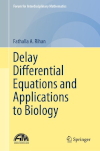- About MAA
- Membership
- MAA Publications
- Periodicals
- Blogs
- MAA Book Series
- MAA Press (an imprint of the AMS)
- MAA Notes
- MAA Reviews
- Mathematical Communication
- Information for Libraries
- Author Resources
- Advertise with MAA
- Meetings
- Competitions
- Programs
- Communities
- MAA Sections
- SIGMAA
- MAA Connect
- Students
- MAA Awards
- Awards Booklets
- Writing Awards
- Teaching Awards
- Service Awards
- Research Awards
- Lecture Awards
- Putnam Competition Individual and Team Winners
- D. E. Shaw Group AMC 8 Awards & Certificates
- Maryam Mirzakhani AMC 10 A Awards & Certificates
- Two Sigma AMC 10 B Awards & Certificates
- Jane Street AMC 12 A Awards & Certificates
- Akamai AMC 12 B Awards & Certificates
- High School Teachers
- News
You are here
Delay Differential Equations and Applications to Biology

Publisher:
Springer
Publication Date:
2021
Number of Pages:
303
Format:
Hardcover
Price:
139.99
ISBN:
978-981-16-0625-0
Category:
Textbook
[Reviewed by , on ]
Bill Satzer
12/12/2021
One of the main ideas behind delay differential equations is to capture the time-delay features of a system evolving in time that regular differential equations (ordinary or partial) can not. A simple example can help clarify this notion. A version of the logistic equation is often used to model the population growth of species that are subject to resource limitations. Such an equation is \( y'(t) = r y(t) (1 - \frac{y(t)}{K}) \) where \( y(t) \) is the population at time \( t \), \( r \), the intrinsic growth rate and \( K \), the environmental carrying capacity, are constants. If one assumes instead that the growth rate depends on the population of the previous generation and also on hatching and maturation periods, a natural modification turns the equation into \( {y'(t) = r y(t)(1 - \frac{y(t - \tau)}{K}}) \). The derivative then depends on both on \( y(t) \) and on the earlier state \( y(t-\tau) \) where the lag \( \tau \) is the maturation time. The presence of a delay often leads to an increase in complexity of the observed behavior and may produce large oscillations in the solution. Nonetheless, such delay models often reproduce more realistic behavior than simple models.
The author introduces several variations of delay differential equations in the first half of the book. These include integro-differential equations such as \( {y' (t) = r y(t) ( 1 - \frac{1} {K }) \int _{t-\tau} ^ {t} y(s) G(t-s) ds } \) for \( t \geq t_0 \), a version of the logistic equation that incorporates all previous states after \( t_0 \), and stochastic versions such as \( dy(t) = r y(t)(1 - \frac{y(t - \tau)}{K}) dt + \sigma dW \) that adds the influence of random noise. Several variations of these kinds of equations are also introduced. The author describes numerical solution methods for each type of equation, stability analysis of the numerical algorithms, and sensitivity analysis.
The second part of the book includes applications and examples of delay differential equations in six areas of biology. Three of these describe models for the spread of disease (including Hepatitis C and Covid19), two treat ecological models, and one describes a model of the interaction between tumors and the immune system. One of the most interesting examples is the model of the dynamics of Hepatitis C virus replication in the presence of treatment with interferon. It uses a fractional-order differential delay equation in combination with an ordinary time delay. This model is capable of representing the immediate cellular reactions and intercellular delay of the viral life cycle, In this way, it can use properties of the fractional derivative to incorporate the memory associated with the viral life cycle.
Differential delay equations with fractional derivatives are also used to model the interactions in a complex predator-prey system with long-term memory effects and to take into account the age structure of the predator population.
The author provides extensive references for each chapter, but there are no exercises. Unfortunately, there is also no index, and its absence makes the book harder to use. The author uses acronyms for various versions of delay equations and their stability properties, and there are a lot of them. If you forget what a particular acronym means, you'll need to page through the book to figure it out.
This book is probably most appropriate for graduate students in mathematics with interests in biological problems, or for biologists with a mathematical background. It offers a breadth of ideas and approaches that could be fertile ground for further research.
Bill Satzer (bsatzer@gmail.com), now retired from 3M Company, spent most of his career as a mathematician working in industry on a variety of applications ranging from speech recognition and network modeling to material science. He did his PhD work in dynamical systems and celestial mechanics.
See the publisher's website.
- Log in to post comments




